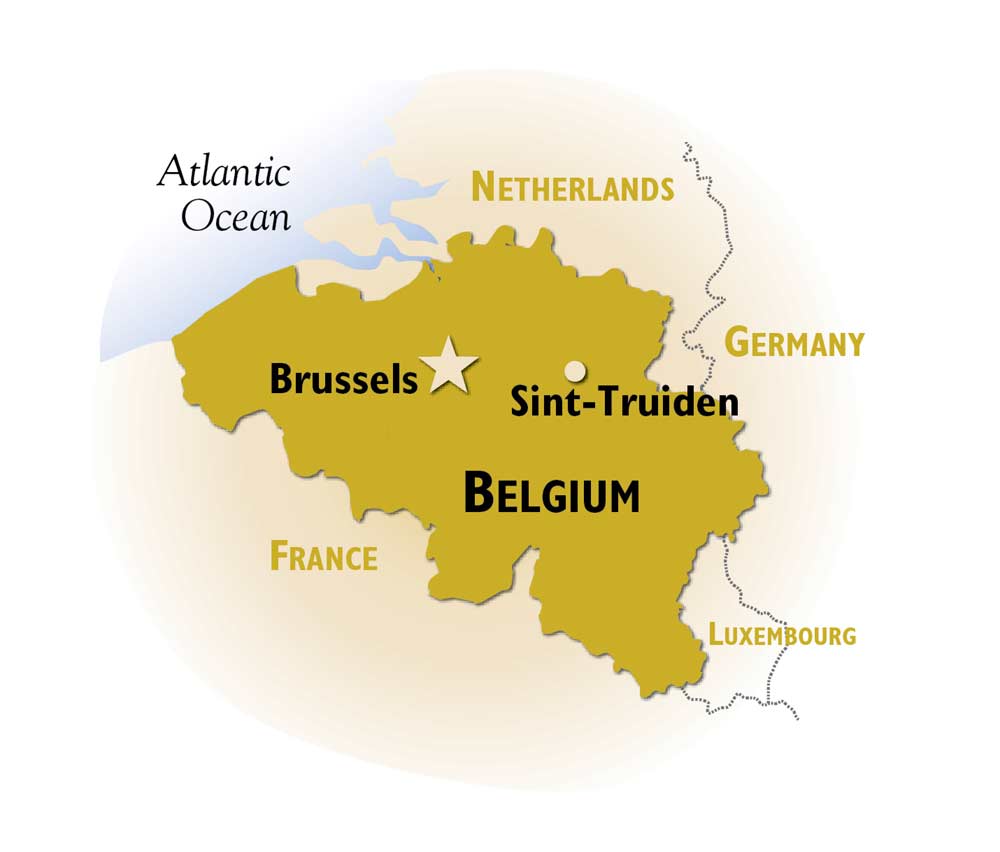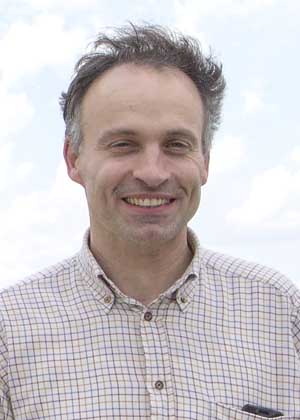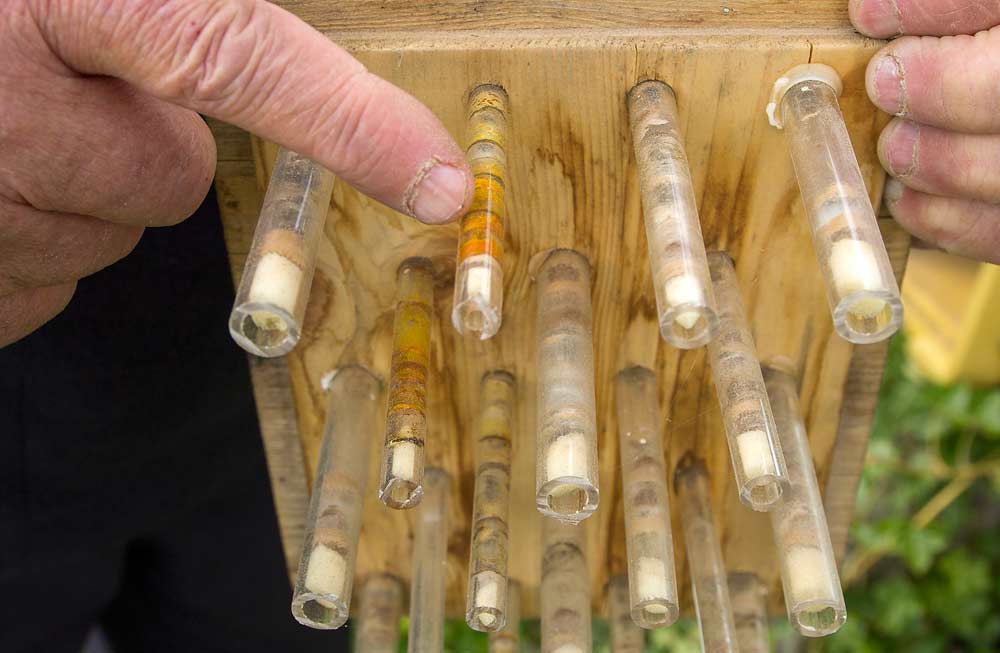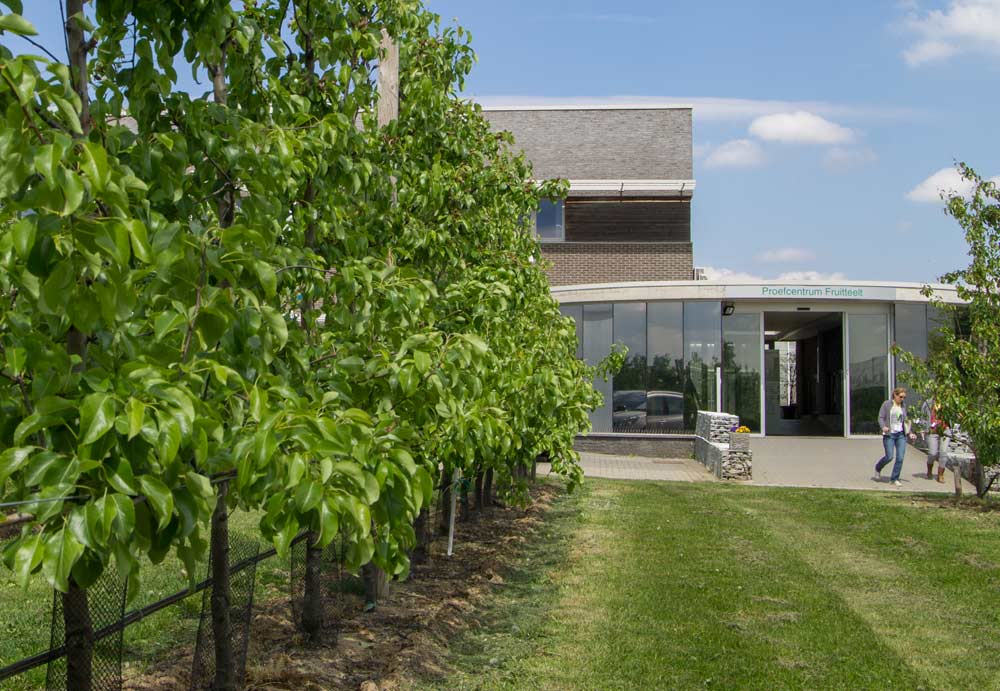
Tree fruit orchards surround the pcfruit research station in Sint-Truiden, Belgium, where researchers are cooperating on a four-year project looking into biocontrol agents for fire blight. Good Fruit Grower visited the station in May to learn more about this project and other research efforts there.
(Shannon Dininny/Good Fruit Grower)
Pear growers have long known about the challenges posed by fire blight, a serious bacterial disease that moves easily with wind, water and insects to infect and kill trees.
It’s highly contagious in the orchard and creates systemic problems for growers, being nearly impossible to prevent and difficult to control.
Conventional growers in the United States are still able to deploy antibiotics for some measure of control, though there have been increasing concerns about the development of resistance in pockets of the country.
However, antibiotics are banned for organic use in the U.S., as they are for both organic and conventional use in Europe, and growers across the world continue to seek tools to better prevent, detect and control the disease.
In Belgium, the disease has been a continuous problem for more than 30 years. To look for solutions, university and research station partners launched a four-year project to identify and examine the efficacy of promising biocontrol organisms.
They are also researching proper application techniques and the role natural pollinators might play to help disperse them.
Belgian growers first began detecting fire blight in ornamentals in the early 1980s and discovered the first infections in apple trees shortly thereafter. It’s been an ongoing problem for pear and apple growers ever since.
Good Fruit Grower recently visited one of those partners, the pcfruit research station in Sint-Truiden, about 40 miles east of the capital city of Brussels, to learn more about the effort.
How big is the problem?

Map of Belgium. (Jared Johnson/Good Fruit Grower illustration)
Bloom is the key season: Fire blight bacteria (Erwinia amylovora) colonize the stigma of open flowers, then move down the style to the base of the flower.
The flower cluster becomes blighted and provides inoculum for shoot infections. In addition to fire blight’s mobility, its sporadic nature makes detection and control difficult.
In Belgium, pear growers sometimes escape fire blight bloom infection thanks to an earlier bloom, which was the case last year. However, warm temperatures combined with rain created a high risk of infection during the later apple bloom, said Hilde Schoofs, a researcher in pcfruit’s pomology department.
“We had to wait until mid-June before the first symptoms really appeared … and then suddenly, it was a disaster in some places,” she said. “We had heavy problems in the orchards where there had already been pressure from the previous years. We had a lot of bloom infections. We also had a lot of fruits and shoots damaged during storms, which is then an entrance point for the bacteria.”
This year, cold nights and frost during bloom eased fire blight pressure for growers, but that doesn’t mean it won’t pose a threat again in the future.
Previous research projects at pcfruit have focused on prediction models and compounds to control the disease, including the plant defense enhancer fosetyl-al, sold under the brand name Aliette.
Applied at the right time in the season, it can improve the quality of the flower buds the following year, ensuring they are more tolerant of infection. In addition, applying it to trees that have been infected results in less inoculum building up in the orchard, reducing disease pressure, Schoofs said.
More recently, research is moving toward detection methods and biocontrol organisms that can be applied to prevent an infection by beating fire blight to the bloom, essentially setting up shop and closing the door to the pathogen.
Biocontrols research
In addition to pcfruit, two universities (University of Leuven and Ghent University) and a second research station (Research Institute for Agriculture, Fisheries and Food) are cooperating on the project.
The latter is genotyping potential biocontrol organisms for apple and pear blooms, with those showing promise advancing to greenhouse testing.
The university researchers are trying to optimize how a biocontrol organism can “stick” to a bumblebee for dispersal in the orchard, analyzing secondary distribution by insects and examining nectar composition of apple and pear blooms to better understand how biocontrols can work successfully to control the disease.

Serge Remy
“Because you are trying to use one organism to suppress another organism, you automatically have to deal with not only the interaction between the two, but also the fact that your biocontrol agent has to establish itself very well — in this case, in the flower,” said Serge Remy, who leads pcfruit’s pomology department.
It’s usually not a problem for a biocontrol organism to grow on the stigma of a flower, but inside the base of the flower, nectar composition — such as the pH or amino acid — may differ, both between apple and pear and between varieties, he said.
“There are many factors that can allow your biocontrol organisms to grow well or not to grow at all,” Remy said. “The first step is to know how well the biocontrol agent can grow in apple and pear flowers, then we are trying to find out how it can be distributed from one flower to another, not only by insects, but also by wind or by rain.”
Pcfruit’s role in the project is to test three different biocontrol organisms. “It’s an alternative approach just to control the fire blight. It’s not curative,” Remy said. “We hope we can lower the number of bacteria present, especially during bloom in the flowers.”
A yeast-like fungal product sold under the brand name Blossom Protect (Aureobasidium pullulans) is already being used by growers in the United States and Europe. Researchers are testing different application methods in Belgian orchards. Two other biocontrol agents also are being tested in greenhouses:
—Serenade (Bacillus subtilis) is not approved for use on apple and pear in Belgium, but is registered for use in the U.S. and Canada.
—Pantoea agglomerans, which is not registered for use in Belgium. Registered compounds containing Pantoea agglomerans are Blossom Bless (registered in New Zealand), Bloomtime (Pantoea agglomerans Eh325, registered in the U.S. and Canada) and Blight Ban (Pantoea vagans C9-1n registered in the U.S.)
Results from these projects are still being evaluated.
Sprayers and bees

Researchers in Belgium have constructed solitary “bee hotels” to increase the pollinator population in a research orchard and to study how these pollinators might help spread biocontrol agents to better prevent and control fire blight.(Shannon Dininny/Good Fruit Grower)
Originally, pcfruit researchers planned to introduce biocontrol organisms for evaluation with bumblebees in a process known as entomovectoring.
Bumblebees would walk across a tray with the biocontrol in powder form inside the hive, then visit flowers to spread the biocontrol agent.
But for that system to work, bumblebees must visit pear and apple flowers. However, they don’t visit pear blooms, and while they visit apple flowers, it’s not sufficient enough to have a high rate for spreading the biocontrol, Remy said. In addition, some biocontrol organisms stick differently to the bumblebees.
Now, researchers are changing their strategy to study how the biocontrol organisms can be applied by spraying, with all natural pollinators spreading the biocontrol from there.

Bees deposit pollen into tubes inside the bee hotels. Pollinators are already being used commercially in greenhouse production of some produce to control for infections other than fire blight, such as botrytis, but the application is more difficult in open orchards where environmental factors play a role. (Shannon Dininny/Good Fruit Grower)
So far, researchers have found that all of the biocontrol organisms show some potential for suppressing fire blight symptoms in pear flowers, but they have been unable to reproduce the results from year to year, Remy said.
Another role of the research is to determine how well and how much of each biocontrol organism is being transferred from one flower to another.
By evaluating DNA of the organism, researchers know how much of a particular biocontrol organism has been transferred, but DNA doesn’t tell them how many of those organisms are actually alive.
That requires classical microbiology techniques, where researchers sample flowers, plate them with different media in a laboratory to allow them to grow and identify the biocontrol organism and count the numbers.
“It’s painstaking work, but you actually need to do both,” Remy said. “DNA cannot counteract Erwinia. You need the living biocontrol organism to do that.”
The research project will continue until September 2018, at which point researchers hope to know more about preventing the spread of the disease and have several promising biocontrol agents that could be tested further for potential development in the private sector in the future.
There is no cure for fire blight, and until new resistant pear varieties are developed, global research will remain focused on ways to better detect, prevent and control the infection. •
The story of pcfruit

The pcfruit research station in Sint-Truiden, Belgium in May, 2017.(Shannon Dininny/Good Fruit Grower)
Pcfruit is a nonprofit research station for tree fruit, pip and stone fruit, strawberries, and small fruit in Sint-Truiden, Belgium, about 40 miles east of the capital city of Brussels.
Founded in 2005 as a merger of three former research institutes and demonstration gardens, the center conducts applied scientific research into pests, diseases, plant physiology and technology, among other things, as well as variety and crop management testing.
Because universities focus more on fundamental research, and centers like pcfruit focus more on applied research, there is little overlap and rather good cooperation on projects, said Dany Bylemans, general director for pcfruit.
The station also is recognized as a reliable, neutral and science-based partner active in several domains of fruit growing. For that reason, it is certified to conduct independent trials of chemicals such as fungicides and herbicides under development in the private sector, as required by the European Union.
That service brings in about a third of the station’s operating revenue, but base money for the center is shrinking. Government subsidies remained at the same level for more than a decade, but two years ago, they dropped 6 percent, Bylemans said.
Belgium also has a price index, which requires salaries to increase with the cost of living, thereby increasing operating costs.
Today, subsidies account for only about 20 percent of the station’s total revenue to cover research and operating expenses.
Another 15 percent comes from contracts with growers for specific services, such as spray calibration and leaf analysis, through a department of staff field advisers. The station also applies for grant funding for about 50 to 60 research projects each year, which makes up about another 15 percent of its revenue.
There are opportunities to be found in these types of projects, Bylemans said. The European Union has a large program for agricultural research, called Horizon 2020, but the pressure is on senior researchers to write proposals for grant funding and network internationally.
While growers in the U.S. are increasingly pitching in to fund agricultural research, either by universities or other nonprofit groups, similar efforts in Belgium generally result in small dollar amounts for very precise, restricted research projects, he said in an email.
“The tendency of less cooperative thinking is a threat for future funding.”
– by Shannon Dininny






Leave A Comment